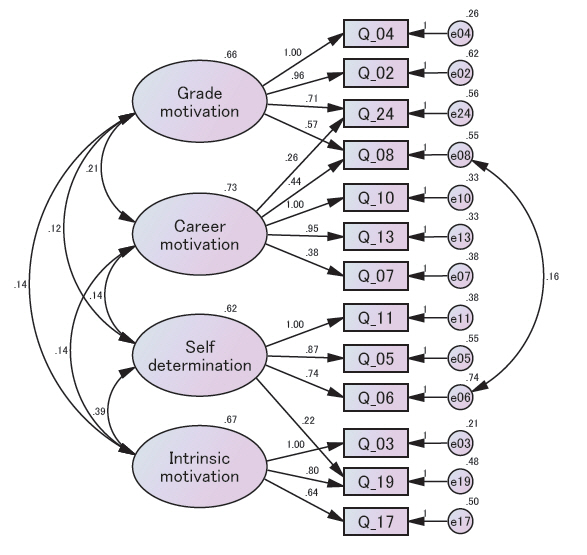J Educ Eval Health Prof.
2017;14:2. 10.3352/jeehp.2017.14.2.
Effect of practical training on the learning motivation profile of Japanese pharmacy students using structural equation modeling
- Affiliations
-
- 1Faculty of Pharmaceutical Sciences, Josai International University, Chiba, Japan. s_yama@jiu.ac.jp
- 2Kitasato University School of pharmacy, Tokyo, Japan.
- KMID: 2406665
- DOI: http://doi.org/10.3352/jeehp.2017.14.2
Abstract
- PURPOSE
To establish a model of Japanese pharmacy students' learning motivation profile and investigate the effects of pharmaceutical practical training programs on their learning motivation.
METHODS
The Science Motivation Questionnaire II was administered to pharmacy students in their 4th (before practical training), 5th (before practical training at clinical sites), and 6th (after all practical training) years of study at Josai International University in April, 2016. Factor analysis and multiple-group structural equation modeling were conducted for data analysis.
RESULTS
A total of 165 students participated. The learning motivation profile was modeled with 4 factors (intrinsic, career, self-determination, and grade motivation), and the most effective learning motivation was grade motivation. In the multiple-group analysis, the fit of the model with the data was acceptable, and the estimated mean value of the factor of "˜self-determination' in the learning motivation profile increased after the practical training programs (P=0.048, Cohen's d=0.43).
CONCLUSION
Practical training programs in a 6-year course were effective for increasing learning motivation, based on "˜self-determination' among Japanese pharmacy students. The results suggest that practical training programs are meaningful not only for providing clinical experience but also for raising learning motivation.
Keyword
MeSH Terms
Figure
Cited by 2 articles
-
Palestinian pharmacists’ knowledge of issues related to using psychotropic medications in older people: a cross-sectional study
Ramzi Shawahna, Mais Khaskiyyi, Hadeel Abdo, Yasmen Msarwe, Rania Odeh, Souad Salame, Sun Huh
J Educ Eval Health Prof. 2017;14:8. doi: 10.3352/jeehp.2017.14.8.Interesting statistics regarding the papers published in
Journal of Educational Evaluation for Health Professions in 2017
Yera Hur, Sun Huh
J Educ Eval Health Prof. 2017;14:36. doi: 10.3352/jeehp.2017.14.36.
Reference
-
References
1. Japan Pharmaceutical Association. Annual report of JPA [Internet]. Tokyo: Japan Pharmaceutical Association;2014–2015. [cited 2017 Jan 18]. Available from: http://www.nichiyaku.or.jp/e/data/anuual_report2014e.pdf.2. Orsini C, Binnie VI, Wilson SL. Determinants and outcomes of motivation in health professions education: a systematic review based on self-determination theory. J Educ Eval Health Prof. 2016; 13:19. https://doi.org/10.3352/jeehp.2016.13.19.
Article3. Orsini C, Evans P, Jerez O. How to encourage intrinsic motivation in the clinical teaching environment?: a systematic review from the self-determination theory. J Educ Eval Health Prof. 2015; 12:8. https://doi.org/10.3352/jeehp.2015.12.8.
Article4. Yamaguchi T, Akiyama S, Sagara H, Tanaka A, Miyauchi Y, Araki H, Shibata K, Izushi F, Namba H. Effects of practical training to increase motivation for learning and related factors. Yakugaku Zasshi. 2014; 134:1227–1235. https://doi.org/10.1248/yakushi.14-00173.
Article5. Glynn SM, Brickman P, Armstrong N, Taasoobshirazi G. Science motivation questionnaire II: validation with science majors and nonscience majors. J Res Sci Teach. 2011; 48:1159–1176. https://doi.org/10.1002/tea.20442.
Article6. Glynn SM. Science motivation questionnaire II with permission directions [Internet]. Athens (GA): The University of Georgia College of Education;2011. [cited 2017 Jan 18]. Available from: https://coe.uga.edu/outreach/programs/science-motivation.7. Byrne BM. Structural equation modeling with AMOS: basic concepts, applications, and programming. 3rd ed. New York (NY): Routledge;2015.8. Kusurkar RA, Ten Cate TJ, Vos CM, Westers P, Croiset G. How motivation affects academic performance: a structural equation modelling analysis. Adv Health Sci Educ Theory Pract. 2013; 18:57–69. https://doi.org/10.1007/s10459-012-9354-3.
Article9. Jeon S, Cho E. Assessment of Korean pharmacy students’ empathy using the Jefferson scale of empathy. Am J Pharm Educ. 2015; 79:67. https://doi.org/10.5688/ajpe79567.
Article10. Deci EL, Ryan RM. Self-determination theory: a macrotheory of human motivation, development, and health. Can Psychol. 2008; 49:182–185. https://doi.org/10.1037/a0012801.
Article11. Grissom RJ, Kim JJ. Effect size for research: univariate and multivariate application. 2nd ed. New York (NY): Routledge;2012.12. Harlow LL, Mulaik SA, Steiger JH. What if there were no significance tests?: classic edition. New York (NY): Routledge;2016.13. Hooper D, Coughlan J, Mullen M. Structural equation modelling: guidelines for determining model fit. Electron J Bus Res Method. 2008; 6:53–60.14. Mayer RE. Learning and instruction. 2nd ed. Upper Saddle River (NJ): Prentice Hall;2008. p. 560.15. Arar NH, Noel PH, Leykum L, Zeber JE, Romero R, Parchman ML. Implementing quality improvement in small, autonomous primary care practices: implications for the patient-centred medical home. Qual Prim Care. 2011; 19:289–300.
- Full Text Links
- Actions
-
Cited
- CITED
-
- Close
- Share
- Similar articles
-
- Exploring the structural relationships between medical students’ motivational regulation, cognitive learning, and academic performance in online learning
- Factors influencing the learning transfer of nursing students in a non-face-to-face educational environment during the COVID-19 pandemic in Korea: a cross-sectional study using structural equation modeling
- The Effect of Using Standardized Patients in Psychiatric Nursing Practical Training for Nursing College Students
- The Mediating Effects of Learning Motivation on the Association between Perceived Stress and Positive-Deactivating Academic Emotions in Nursing Students Undergoing Skills Training
- Effective Teaching Skills in Pharmacy Practice Education


